Never (hardly) ever lose a fish
How to avoid that awkward feeling of your line going limp
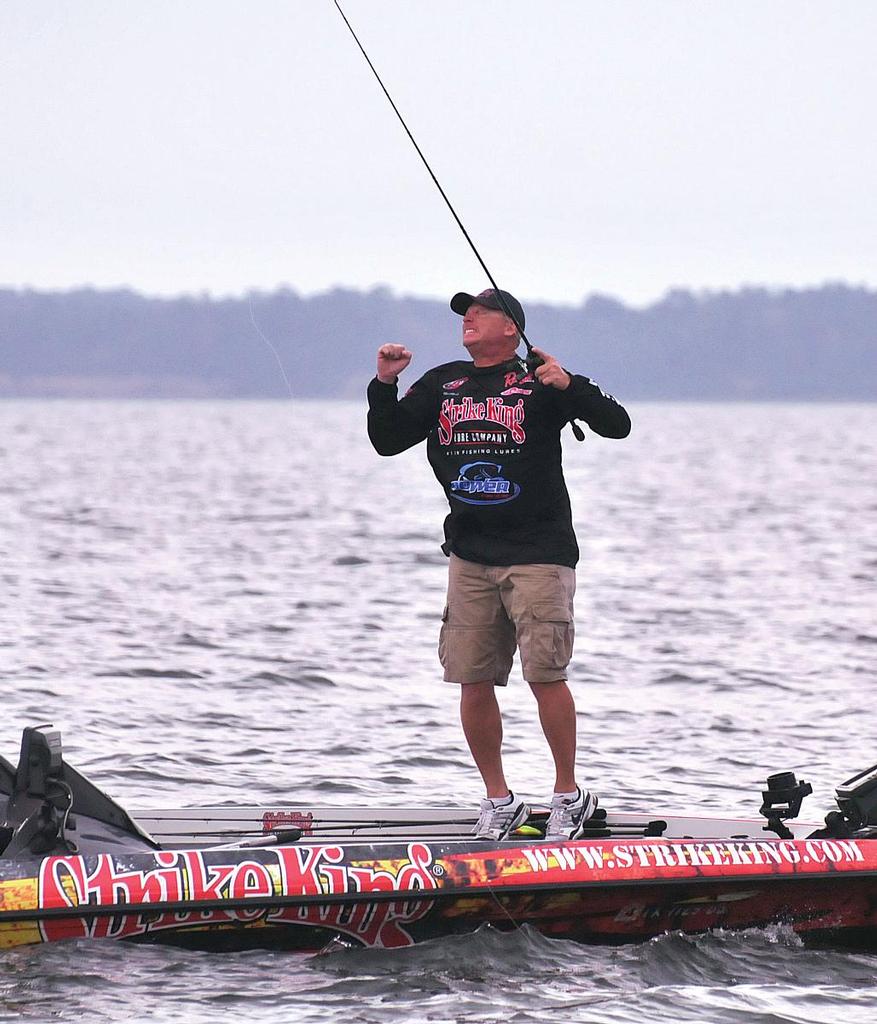
(Editor’s note: This article originally appeared in the 2013 February issue of Bass Fishing magazine. To read more compelling articles from Bass Fishing magazine each month, become an FLW subscriber member. If you’d like to sign up for a digital subscription to access articles online, click here).
You’ve heard them on the weigh-in stand, those tournament fishermen who look crestfallen and whipped – the guys who won’t get to hold the giant check over their heads. There are variations to their short concession speeches, but most have the same thing to say: “I had the winning fish on, but I just couldn’t get ’em in the boat.”
And maybe you’ve been there yourself. How many good fish do you lose in a season of fishing, whether it’s in a tournament or just when you’re fishing for the fun of it? If it’s more than you can count on your fingers, perhaps it’s time for some constructive self-criticism. Are the fish at fault, or are you? In case it’s the latter, we offer the following advice, observations and tips from some top pros regarding how to put the odds of landing a fish successfully more in your favor.
Mark Rose
Take a pass on flimsy crankbait rods
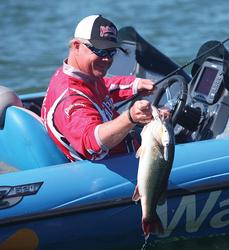 What’s going on: When you’re fishing with crankbaits, it all begins with a solid hookset. There’s been another school of thought lately that you need to loosen your drag and use flimsy rods so that the fish won’t pull off, but I believe that most of the time when you lose a fish, it’s because the hookset wasn’t forceful enough.
What’s going on: When you’re fishing with crankbaits, it all begins with a solid hookset. There’s been another school of thought lately that you need to loosen your drag and use flimsy rods so that the fish won’t pull off, but I believe that most of the time when you lose a fish, it’s because the hookset wasn’t forceful enough.
Getting it done: I use a 7-foot, 11-inch Kistler MRO (Mark Rose Offshore) rod with medium-heavy action. It has enough backbone to set the hook, but also has some give in the tip so that a good fish is less likely to freight-train you at the boat and pull off or break your line. Also, if you’re using 8- to 12-pound-test fluorocarbon instead of monofilament, you’ll get a better hookset because there’s no stretch. The only time I use monofilament [when fishing a crankbait] is when I’m fishing fairly shallow and making short casts around wood cover.
Bottom line: I understand the philosophy of using fiberglass rods with softer parabolic action and loosening the drag, but I think that’s more about getting past those last surges at the boat than anything else. To me, a long graphite rod with medium-heavy action is the perfect crankbait rod. You can really lean in to a fish and that long rod moves a lot of line on the hookset, but the soft tip has enough “give” to get you past those scary moments at the boat.
Having said all that, there are going to be times when you lose a fish, whether you’re using a crankbait or a jig. The best you can hope for is to cut down on the number of lost fish, and, like I said, that begins with the hookset.
David Dudley
Set a hook like you mean it
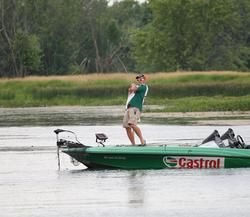 What’s going on: Most of the time you lose a fish because the hookset wasn’t forceful enough. Use as stout a rod as you can get by with to get the lure in the water because you really want to sink the hook, especially if there’s any distance between you and the fish.
What’s going on: Most of the time you lose a fish because the hookset wasn’t forceful enough. Use as stout a rod as you can get by with to get the lure in the water because you really want to sink the hook, especially if there’s any distance between you and the fish.
Getting it done: If you get a hook point in past the barb, usually that fish is coming in the boat. Depending on how strong your line is, you should set the hook with as much force as you can. Also, when you’re bringing a fish to the boat, you should keep pressure on it all the way. On a scale of 1 to 10, with 10 being maximum pressure, I keep it at about 7 on average because there are variables such as cover, the strength of the line and the size of the fish that change. If I sense the fish is about to jump, I hold the rod down and try to discourage it from jumping. If it does, I still maintain pressure and keep it coming.
Bottom line: A bad hookset is usually a case of operator error. Either the rod you’re using isn’t stiff enough, or you don’t use enough force to set the hook properly – or both.
Dave Lefebre
Maximize your net benefits
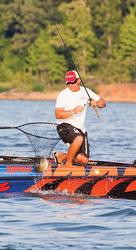 What’s going on: If you’re losing fish at the boat before you can get them in the net, it’s probably because either you have the wrong net or you’re not using it correctly. The best net is the lightest one available that is also strong and has the least resistance in the water. You want a net that’s quick-handling because things can happen fast with a big fish at the boat. The smaller a net’s mesh, the more resistance it has, and using some of those big rubber-coated jobs is like trying to pull in a drift sock. I always talk to my co-angler first thing in the morning and let him know that I’m going to net his fish if they need netting and I expect the same from him. You don’t want to wait until you’re trying to get a good fish in the boat to have a discussion about netting procedure.
What’s going on: If you’re losing fish at the boat before you can get them in the net, it’s probably because either you have the wrong net or you’re not using it correctly. The best net is the lightest one available that is also strong and has the least resistance in the water. You want a net that’s quick-handling because things can happen fast with a big fish at the boat. The smaller a net’s mesh, the more resistance it has, and using some of those big rubber-coated jobs is like trying to pull in a drift sock. I always talk to my co-angler first thing in the morning and let him know that I’m going to net his fish if they need netting and I expect the same from him. You don’t want to wait until you’re trying to get a good fish in the boat to have a discussion about netting procedure.
Getting it done: A lot of guys put a net in the water and expect you to lead the fish into it. Sometimes that works, but my best advice is that you net a fish any way you can as soon as you can. If somebody is netting my fish, I want his rod and reel on the deck as soon as possible and his two hands on the net. I want him focused, because that’s what I’m going to be doing when I net his fish.
It’s kind of scary, but the easiest fish to net is the one that jumps at the boat. Try to make it jump if you can. If you’re ready with the net, you just sweep it down to where the fish is going to land and have the mouth [of the net] in the direction it’s going, and you bag it.
Bottom line: Always net a fish that’s hooked with treble hooks, unless it’s small or you’re not too concerned about whether it gets off or not when you swing it in the boat.
Randall Tharp
In a pinch, swing a big bass
What’s going on: If you have time to net a big fish, or any fish you’ve hooked on trebles, you’re better off netting it. A lot depends on the circumstances and how you’re fishing. If I’m fishing weeds with something with a single hook in it, chances are I’m using a really stiff rod and heavy braid, and I’m pretty much fishing right out in front of me. So if I hook up and the bass is coming toward me, I’m going to boat-flip it. I won’t boat-flip a 10-pounder, but I’ve boat-flipped some 8-pounders before.
Getting it done: Stiff rod, strong line – that’s pretty basic, but you also need a wide-gap, extra-strong hook that’s not going to bend. Once you’ve got all the slack out and the fish is at the boat, quickly grip the rod above the handle with your reel hand, push the butt of the rod down with the other and pivot so the fish swings aboard.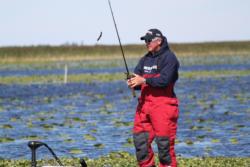
Bottom line: The fish needs to be coming toward you when you start lifting it out of the water. If it’s lunging away from the boat, or jumping away from you, better to wait. You’ve got to have the fish’s momentum working for you rather than against you.
Clark Wendlandt
Don’t get hung up on hooks
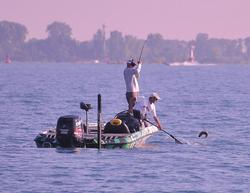 What’s going on: Using the wrong hook will cost you some fish. If it’s too big you might not penetrate the fish’s mouth well enough. If it’s too light, the fish might pull off.
What’s going on: Using the wrong hook will cost you some fish. If it’s too big you might not penetrate the fish’s mouth well enough. If it’s too light, the fish might pull off.
Getting it done: If I’m fishing heavy grass mats or any other heavy cover, I’m going to be fishing with a straight-shank, heavy-wire hook. Most of the energy of your hookset is going to come at the point of the hook, where you want it. In heavy grass you’re going to be fishing close, and you want to get any fish you hook out of there as quickly as possible. So having a stronger hook is more important than having a hook made out of lighter wire that is sharper and makes a better hookset over distance. If you’re fishing grass, chances are you’re going to be using braid. Choose a hook with a welded eye rather than a bent-around eye, because I guarantee you the braid will find a way to get under the gap and get cut or come loose.
All of the new specialized hooks are good choices when you’re fishing a shaky head or drop-shotting or using any other light-line presentation.
Bottom line: With a heavy hook and line, you can really rear back and sink the point with force. With lighter equipment in open water, it’s more of a sweep-set where you take into account the line’s breaking strength and the distance you are from the fish.
Stetson Blaylock
Make it easier for the fish to catch themselves
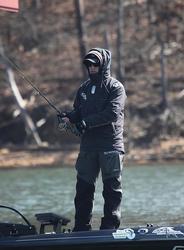 What’s going on: Fish sometimes come unbuttoned simply because they didn’t take the lure forcefully enough for a solid hookset. Take what little bit you learn from your first couple of bites and act on that. This assumes that you’re using the right rod for the technique.
What’s going on: Fish sometimes come unbuttoned simply because they didn’t take the lure forcefully enough for a solid hookset. Take what little bit you learn from your first couple of bites and act on that. This assumes that you’re using the right rod for the technique.
Getting it done: If you’re missing a lot of fish, or if they’re coming off, first check the hooks. If they’re in good shape, you might want to downsize your line and your lure. Most of the time, in my opinion, it’s the line size that causes fish to be a little leery – especially in the winter. Don’t use lighter line than you have to, though, because you want to get a bass in the boat as quick as you can. You don’t want to horse a fish in, necessarily, but the longer you let a fish fight, the better its chances of getting off. If the fish seem to be nipping at a lure, slow down or speed up the retrieve to see how they react, and then give them what they want. Also, change the lure color, and put on bigger hooks.
Bottom line: There are days when there’s not much you can do to keep from missing at least a few bites. Sometimes it’s the angle that a fish comes in and takes the lure – front, back, top, side – that’s not conducive to a good hookset. You might be able to move your boat to change the fish’s angle of approach. Otherwise, you just do what you can, knowing that the next time might be one of those days when you can’t do anything wrong and every bite winds up in the boat.
Dion Hibdon
Snell a hook for better penetration
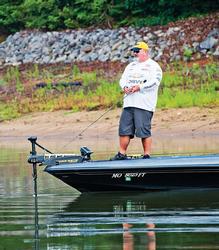 What’s going on: One reason you lose a lot of bass with a Texas-rigged lure is because the hook catches in a place that won’t hold, such as in the connecting tissue of its lower jaw. It’s like trying to set a hook in a piece of toilet paper. The optimum place to hook a bass is in the top of its mouth; that’s where all the bone and hard cartilage is. Anything that helps you do that will make a big difference in your catch rate.
What’s going on: One reason you lose a lot of bass with a Texas-rigged lure is because the hook catches in a place that won’t hold, such as in the connecting tissue of its lower jaw. It’s like trying to set a hook in a piece of toilet paper. The optimum place to hook a bass is in the top of its mouth; that’s where all the bone and hard cartilage is. Anything that helps you do that will make a big difference in your catch rate.
Getting it done: Whenever you’re flipping heavy vegetation such as matted grass or even buck brush, use a snell knot to connect your hook to your line. It’s an easy knot to tie, and there are illustrations all over the Internet that show how to tie one.
Bottom line: Basically, when you set the hook, a snell knot straightens the hook vertically, and the point tends to pivot up. Your chances of sinking the hook in the top of the fish’s mouth are much better.